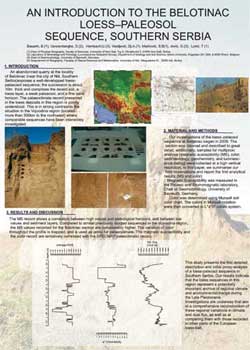LOESSFEST'09 | Aug. 31st – Sept. 3rd, 2009 |Novi Sad-Serbia
An Introduction to the Belotinac Loess–Palaeosol Sequence, Southern Serbia
Basarin, B.1, Vandenberghe, D.2, Hambach,U.3, Vasiljević, Dj.A.1, Marković, S.B.1, Jović, G.4, Lukić, T.1
1Chair of Physical Geography, Faculty of Sciences, University of Novi Sad, Trg D. Obradovića 3, 21000 Novi Sad, Serbia
2Laboratory of Mineralogy and Petrology (Luminescence Research Group), Department of Geology and Soil Science, Ghent University, Krijgslaan 281 (S8), B-9000 Ghent, Belgium
3Chair of Geomorphology, University of Bayreuth, Germany
4Deapratment of Geography, Faculaty of Natural Sciences and Mathematics, University of Niš, Višegradska 33, 18000 Niš, Serbia
An abandonned quarry at the locality of Belotinac (near the city of Niš, Southern Serbia) exposes a well-developped loess-palaeosol sequence; the succession is about 10m thick and comprises the recent soil, a loess layer, a weak palaeosol, and a fine sand horizon. The palaeoclimate record preserved in the loess deposits in this region is poorly understood. This is in strong contrast to the situation in the Vojvodina region (located more than 300km to the northwest) where comparable sequences have been intensively investigated.
 Our investigations of the loess–paleosol sequence at Belotinac began in 2009.
The section was cleaned and described to great detail; additionally, samples for
multiproxi analysis [magnetic susceptibility (MS), color, sedimentology, geochemistry,
and luminescence dating] were collected at a high vertical resolution.
In this paper, we summarise our field observations and report the first analytical
results (MS and color).
Our investigations of the loess–paleosol sequence at Belotinac began in 2009.
The section was cleaned and described to great detail; additionally, samples for
multiproxi analysis [magnetic susceptibility (MS), color, sedimentology, geochemistry,
and luminescence dating] were collected at a high vertical resolution.
In this paper, we summarise our field observations and report the first analytical
results (MS and color).
The MS record shows a correlation between high values and pedological horizons,
and between low values and sediment layers. Compared to similar previously
studied sequences in the Vojvodina region, the MS values recorded for the
Belotinac section are considerably higher. The variation of color throughout the
profile is mapped, and is used as proxy for palaeoclimate. The magnetic susceptibility
and the color record are tentatively correlated with the SPECMAP paleoclimatic
record.
This study presents the first detailed description and initial proxy-analysis of
a loess-paleosol sequence in Southern Serbia. Our results indicate that the loess
sequences in this region represent a potentially important archive of regional climate
and environmental change during the Late Pleistocene. Investigations are
underway that aim at a comprehensive reconstruction of these regional variations
in climate and dust flux, as well as at comparing them with those recorded in other
parts of the European loess belt.



